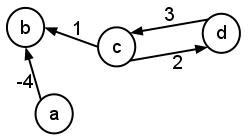In this problem we will analyze Dijkstra's algorithm as given in lecture:
Dijkstra(G, s):
for each vertex v in G:
d[v] = INFINITY
d[s] = 0
PQ = make empty heap
PQ.insert(s with priority 0)
while !PQ.isEmpty():
current = PQ.removeMin()
for each neighbor v of current:
if d[v] > d[current] + weight(current, v):
d[v] = d[current] + weight(current, v)
PQ.insertOrUpdatePriority(v with priority d[v])
Assume that Dijkstra's algorithm is executing on a graph with n
vertices and m edges, and that PQ.insertOrUpdatePriority has a
worst-case running time of O(lg n) for a heap containing n items.
- In the worst-case, how many items might be stored in the heap PQ?
- In the pseudocode above, d is a dictionary where each key is
some vertex v and the value is the currently-shortest-known
distance from s to v. How many key-value pairs are stored
in this dictionary? What data structure might you use to store this
dictionary, and what is the running time of getting or setting
the value for a key?
- For a single neighbor v of some current vertex,
what is the running time of that neighbor's single execution of
the inner for-loop:
if d[v] > d[current] + weight(current, v):
d[v] = d[current] + weight(current, v)
PQ.insertOrUpdatePriority(v with priority d[v])
- How many total times will that inner for-loop execute for the entire
graph? In other words, in terms of n and m,
how many neighbors (total) are in the graph?
- The analysis of part (d) is a bit strange at first because we're
considering the total number of neighbors in the entire graph rather than
just the neighbors of the current vertex (which varies from
graph to graph). This allows us to analyze the total cost of all executions
of the for-loop (in sum, for all executions of the while-loop), though,
rather than just analyze the cost of exploring the current vertex's neighbors.
The total cost of all executions of the inner for-loop is then:
O( #num_neighbors +
#num_neighbors*cost_of_each_for_loop_execution )
(The first term, #num_neighbors, is the total cost of getting the neighbors
for every vertex in the graph using an adjacency-list representation.
The second term is the product of (c) and (d) above.)
Combine your answers to part (c) and (d) to determine the total cost of
executing the for-loop.
- The only remaining costs in this algorithm are the initialization cost
(before the while-loop) and the total cost of executing the line
current = PQ.removeMin()
for all executions of the while-loop.
What are these costs, in terms of n and m? What is the
total cost of Dijkstra's algorithm?
